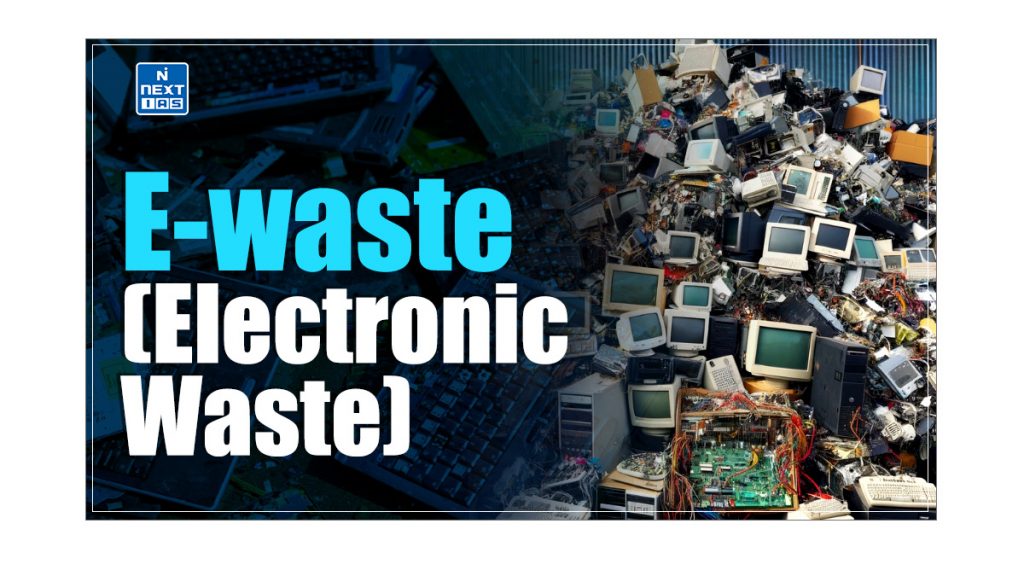
E-waste, or Electronic Waste, has emerged as a significant environmental concern due to its rapid accumulation and hazardous components. As technological advancements continue to accelerate, disposing of obsolete electronic devices poses a pressing challenge for governments, industries, and individuals. This article provides a comprehensive overview of e-waste, or electronic waste, its meaning, sources, impacts and consequences, control measures, and potential solutions to address it.
What is E-Waste?
- E-waste or electronic waste refers to electronic goods and equipment that are being dumped or discarded after being used.
- This includes computers, televisions, mobile phones, printers, refrigerators, and air conditioners.
- E-waste often contains hazardous substances like lead, mercury, cadmium, and chromium, which can contaminate the environment if not disposed of properly.
Types of E-Waste
The types of e-waste are as follows:
- Large Household Appliances: Refrigerators, washing machines, air conditioners, and dishwashers.
- Small Household Appliances: Microwaves, toasters, vacuum cleaners, and coffee machines.
- IT and Telecommunication Equipment: Computers, laptops, printers, and smartphones.
- Consumer Electronics: Televisions, cameras, DVD players, and game consoles.
- Lighting Equipment: Fluorescent lamps, LED bulbs, and other lighting devices.
- Electrical and Electronic Tools: Power drills, saws, and gardening tools.
- Medical Devices: Monitoring and control instruments, as well as diagnostic devices.
- Toys and Leisure Equipment: Electronic toys and sports equipment with electrical components.
E-Waste Constituents and Their Health Effects
- Electrical and electronic equipment often contains hazardous materials, which can be harmful to human health and the environment if not disposed of carefully.
- Some of the most harmful constituents of e-waste management and their impact are mentioned below:

| Component | Impacts |
|---|---|
| Arsenic | Affects the lungs and kidneys. Prolonged exposure has a carcinogenic effect. |
| Barium | This results in breathing problems, bowel irritation, and slowing down of the nerve reflexes. |
| Beryllium | Causes lung cancer |
| Cadmium | It primarily affects the kidneys. Chronic exposure can also result in muscle weakness, central nervous system disorders, and other conditions. |
| Lead | Diarrhea, convulsions, appetite loss, irritability and headache. |
Global Status of E-waste Generation
It is estimated that around 50 million tons of e-waste are produced yearly globally.
Sources of E-Waste
The sources of e-waste are as follows:
- Household Appliances: Devices like refrigerators, washing machines, microwaves, and vacuum cleaners contribute significantly to e-waste.
- IT and Communication Devices: Due to rapid technological advancement, computers, laptops, smartphones, tablets, and printers are a major source of electronic waste.
- Consumer Electronics: Televisions, DVD players, cameras, and gaming consoles, which often become obsolete quickly, add to e-waste.
- Medical Equipment: Discarded medical devices like pacemakers, diagnostic machines, and monitoring equipment contribute to e-waste.
- Industrial Equipment: Equipment used in industries, such as motors, pumps, and transformers, also generates e-waste when outdated or broken.
- Office Equipment: Printers, photocopiers, scanners, and other office machinery often become e-waste due to frequent upgrades and wear.
- Lighting Devices: Fluorescent lamps, LEDs, and other lighting equipment are a lesser-known but important source of e-waste.
Status of E-waste Generation in India
- India is the world’s third largest generator of e-waste after China and the US, according to the UN Global E-Waste Monitor Report.
| Note: Maharashtra generates the most e-waste among all the Indian states. |
- The exponential penetration of cellular technology is the chief culprit, as telecom equipment accounts for about 12 per cent of the total e-waste generated in the country.
- This alarming rise in the levels of e-waste generation in India has been a matter of concern in recent years.

Measures Taken to Tackle E-Waste in India
- To address the growing e-waste problem, India introduced its first set of e-waste Rules in 2011, which came into effect in 2012.
- One crucial aspect of the 2011 Rules was the concept of Extended Producer Responsibility (EPR), under which producers are held accountable for the proper disposal of electronic and electrical products once consumers discard them.
- The E-waste Rules of 2016, subsequently amended in 2018, expanded on these provisions and introduced measures to promote “authorisation” and “product stewardship.”
- Additionally, the rules introduced “Producer Responsibility Organizations (PRO)” as key stakeholders.
- The Ministry of Environment and Forests announced new e-waste rules in November 2022, which took effect on April 1, 2023.
Status of E-Waste Management in India
The status of e-waste management in India are as follows:

- According to a report by the Indian Cellular and Electronics Association (ICEA), the management of e-waste in India is primarily informal. The informal sector handles approximately 90% of e-waste collection and 70% of recycling.
- Only 22.7 per cent of the e-waste generated in 2019-20 in India, 10,149,61.21 tonnes, was collected, dismantled, and recycled or disposed of.
- E-waste management typically is not included in the municipal solid waste list; therefore, it is not a direct mandate for cities to collect, transport, and manage it.
| Note: Uttar Pradesh, Uttarakhand, Tamil Nadu, and Haryana are the States with the largest capacity to dismantle and recycle e-waste management. |
Major Issues related to E-waste in India
The major issues related to e-waste management in India are as follows:
- Involvement of Child Labor: In India, about 4.5 lakh child labourers in the age group of 10-14 are observed to be engaged in various e-waste management activities, and that is also true without adequate protection and safeguards in various yards and recycling workshops.
- Ineffective Legislation: No public information on most SPCBs/PCC websites is absent.
- Even the basic E-waste Rules and guidelines have yet to be uploaded.
- Lack of Infrastructure: There is a huge gap between present recycling and collection facilities and the quantum of E-waste management that is being generated.
- Lack of Incentive Schemes: No clear guidelines exist for the unorganised sector to manage E-waste.
- Also, no incentives are mentioned to lure people to adopt a formal path for handling e-waste management.
- E-waste Imports: Eighty per cent of E-waste management in developed countries meant for recycling is sent to developing countries such as India, China, Ghana, and Nigeria.
E-waste Rules 2022
The e-waste management rules of 2022 are as follows:
- Application:
- It will apply to every manufacturer, producer, refurbisher, dismantler and recycler involved in the manufacturing, sale, transfer, purchase, refurbishing, dismantling, recycling and processing of e-waste management or electrical and electronic equipment.
- The rule applies to all electrical devices and radiotherapy equipment, nuclear medicine equipment and accessories, Magnetic Resonance Imaging (MRI), electric toys, air conditioners, microwaves, tablets, washing machines, refrigerators, and iPads, among others.
- Restrictions:
- The government has restricted the use of hazardous substances in manufacturing electrical and electronic equipment (EEE) following deaths due to exposure to radioactive material.
- It mandates reducing the use of lead, mercury, and cadmium, among other elements, in the manufacturing of electronic equipment.
- Reuse and Recycling:
- Manufacturers shall use technology or methods to make the end product recyclable. They shall ensure that components or parts made by different manufacturers are compatible with each other to reduce the quantity of e-waste management.
- Strict Monitoring:
- The Central Pollution Control Board shall randomly sample electrical and electronic equipment placed on the market to monitor and verify compliance with the provisions for reducing hazardous substances.
- If a product does not comply with the e-waste management rules, the manufacturer must withdraw all samples from the market.
- Extended Producer Responsibility Certificates:
- Draft rules aim to incentivise registered electronic waste recyclers by introducing EPR or Extended Producer Responsibility certificates (which were not part of the 2016 Rules).
- E-waste exchange facilities:
- The EPR requires producers to set up e-waste management exchange facilities to facilitate collection and recycling and assign specific responsibility to bulk consumers of electronic products for safe disposal.
- Imports:
- Imports or placement in the market for new electrical and electronic equipment shall be permitted only for those that are compliant with provisions laid down by the government.
- Disposal:
- The manufacturer collects e-waste management generated during manufacturing and ensures its recycling or disposal.
- However, the rule does not apply to waste batteries, packaging plastics, micro-enterprises, and radioactive waste, as covered by the provisions of the law.
Significance of E-waste Rules
The significance of the new e-waste management rules could be appreciated from the below-mentioned points:
- The e-waste rules provide manufacturers with various options, such as collecting a refundable deposit from customers and paying for the return of goods to meet the stipulated requirements.
- Including mercury light bulbs in the category of e-waste management would result in their sustainable disposal and avoid mixing with municipal solid waste.
Challenges in Implementation of E-waste
- The biggest challenge will be the fact that a large part of our current e-waste management is in the informal sector.
- According to the ASSOCHAM report, roughly 2% of India’s total e-waste management is recycled by formal recyclers and trained professionals and approved by state boards.
- The regulatory structure has so far yet to tackle this inadequacy of the trained workforce.
- Another big challenge is the regulatory architecture for e-waste management.
- Both central and state pollution control boards need to be more staffed, have deficient financial resources and lack technical capabilities.
- Giving these regulators more responsibility without addressing these factors would serve little purpose in handling e-waste management.
- New rules are also focused on something other than the consumers.
- Consumer awareness of the hazards of e-waste management is a prerequisite to making consumers stakeholders in the disposal of e-waste management and ensuring the organisation’s accountability in this process.
Conclusion
E-waste management, or electronic waste, is a growing global challenge that requires urgent attention and action. Addressing e-waste management involves a comprehensive approach that includes effective policy measures, improved recycling infrastructure, public awareness, and innovation in product design. As we move further into the digital age, tackling the e-waste crisis will be essential for protecting our environment and ensuring the well-being of future generations.
Frequently Asked Questions (FAQs)
What is Electronic Waste?
Electronic waste, or e-waste management, refers to discarded electrical and electronic devices like computers, smartphones, TVs, and household appliances.
What are 4 examples of e-waste?
Four examples of e-waste management include old smartphones, discarded computers, broken televisions, and non-functional washing machines.
What are the types of electronic waste?
Types of e-waste management include large household appliances (e.g. refrigerators), small appliances (e.g. microwaves), IT and communication equipment (e.g. laptops), and consumer electronics (e.g. cameras).
How to reduce e-waste?
To reduce e-waste management, focus on repairing and upgrading devices, recycling old electronics, buying durable products, and responsibly disposing of gadgets at e-waste recycling centres.






